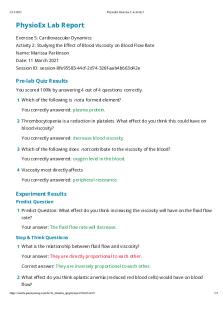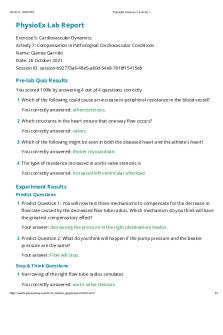Physio Ex Exercise 2 Activity 5 PDF

| Title | Physio Ex Exercise 2 Activity 5 |
|---|---|
| Course | Anatomy And Physiology |
| Institution | Community College of Rhode Island |
| Pages | 4 |
| File Size | 188.4 KB |
| File Type | |
| Total Downloads | 8 |
| Total Views | 146 |
Summary
Pearson PhysioEx Lab ...
Description
PhysioEx Lab Report Exercise 2: Skeletal Muscle Physiology Activity 5: Fatigue in Isolated Skeletal Muscle Name: Kaley Faucher Date: 15 September 2020 Session ID: session-ba8e2e23-b8a3-496e-3e6c-541f99053848
Pre-lab Quiz Results You scored 100% by answering 4 out of 4 questions correctly. 1 When skeletal muscle twitches fuse so that the peaks and valleys of each twitch become indistinguishable from each other, the muscle is in a state known as You correctly answered: complete (fused) tetanus. 2 When the stimulus frequency reaches a value beyond which no further increase of skeletal muscle force can occur, the muscle has reached its You correctly answered: maximal tetanic tension. 3 A decline in a muscle's ability to maintain a constant level of force, or tension, after prolonged, repetitive stimulation is called You correctly answered: fatigue. 4 Which of the following is not thought to be a contributing factor to the development of fatigue? You correctly answered: buildup of Ca 2+ in the muscle fibers.
Experiment Results Predict Question 1 Predict Question: If the stimulator is briefly turned off for defined periods of time, what will happen to the length of time that the muscle is able to sustain maximal developed tension when the stimulator is turned on again? Your answer: The length of the rest period will not substantially impact the length of time for sustained muscle tension. Stop & Think Questions
1 Why does the stimulated muscle force begin to decrease over time despite the maintained stimuli? (Note that a decrease in maximal force indicates muscle fatigue is developing.) You correctly answered: More than one of these answers could be correct. 2 Why did the length of the intervening rest period affect the length of time the skeletal muscle can maintain maximum tension once the stimulator is turned on again? You correctly answered: Intracellular concentrations of ADP and P i declined during the rest period. Experiment Data Voltage (v)
Stimuli/sec
Rest Period (sec)
Active Force
Sustained Maximal Force (sec)
8.5
120
0
5.86
0.08
8.5
120
0
5.86
0.08
8.5
120
12
5.86
0.02
8.5
120
22
5.86
0.06
120 Stimuli/sec at 8.5 V
120 Stimuli/sec at 8.5 V
Post-lab Quiz Results You scored 100% by answering 5 out of 5 questions correctly. 1 During cross bridge cycling in skeletal muscle, force is created by the You correctly answered: power stroke of the myosin heads. 2 The term tetanus refers to You correctly answered: sustained muscle tension due to repetitive stimuli. 3 A decline in a muscle's ability to maintain a constant level of force, or tension, after prolonged, repetitive stimulation is called You correctly answered: fatigue. 4 During fatigue You correctly answered: the number of active cross bridges begins to decline although the rate of stimulus delivery (frequency) remains constant. 5 If an intervening rest period is imposed on active skeletal muscle You correctly answered: the development of fatigue will be delayed.
Review Sheet Results 1 When a skeletal muscle fatigues, what happens to the contractile force over time? Your answer: The force decreases. 2 What are some proposed causes of skeletal muscle fatigue?
Your answer: High concentrations of lactic acid, ADP and Pi. 3 Turning the stimulator off allows a small measure of muscle recovery. Thus, the muscle will produce more force for a longer time period if the stimulator is briefly turned off than if the stimuli were allowed to continue without interruption. Explain why this might occur. How well did the results compare with your prediction? Your answer: If there is more resting time between the stimulations, the muscle has a great period of time it can sustain maximal developed tension. 4 List a few ways that humans could delay the onset of fatigue when they are vigorously using their skeletal muscles. Your answer: Take longer breaks between workouts, healthy diet, proper body mechanics, hydration, edurance training....
Similar Free PDFs

Physio Ex Exercise 2 Activity 5
- 4 Pages

Physio Ex Exercise 5 Activity 2
- 3 Pages

Physio Ex Exercise 2 Activity 5
- 4 Pages

Physio Ex Exercise 5 Activity 2
- 3 Pages

Physio Ex Exercise 5 Activity 5
- 3 Pages

Physio Ex Exercise 5 Activity 5
- 2 Pages

Physio Ex Exercise 5 Activity 5
- 3 Pages

Physio Ex Exercise 5 Activity 5
- 3 Pages

Physio Ex Exercise 6 Activity 5
- 4 Pages

Physio Ex Exercise 5 Activity 6
- 3 Pages

Physio Ex Exercise 5 Activity 6
- 3 Pages

Physio Ex Exercise 5 Activity 7
- 3 Pages

Physio Ex Exercise 5 Activity 4
- 3 Pages

Physio Ex Exercise 1 Activity 5
- 3 Pages

Physio Ex Exercise 3 Activity 5
- 7 Pages

Physio Ex Exercise 5 Activity 6
- 3 Pages
Popular Institutions
- Tinajero National High School - Annex
- Politeknik Caltex Riau
- Yokohama City University
- SGT University
- University of Al-Qadisiyah
- Divine Word College of Vigan
- Techniek College Rotterdam
- Universidade de Santiago
- Universiti Teknologi MARA Cawangan Johor Kampus Pasir Gudang
- Poltekkes Kemenkes Yogyakarta
- Baguio City National High School
- Colegio san marcos
- preparatoria uno
- Centro de Bachillerato Tecnológico Industrial y de Servicios No. 107
- Dalian Maritime University
- Quang Trung Secondary School
- Colegio Tecnológico en Informática
- Corporación Regional de Educación Superior
- Grupo CEDVA
- Dar Al Uloom University
- Centro de Estudios Preuniversitarios de la Universidad Nacional de Ingeniería
- 上智大学
- Aakash International School, Nuna Majara
- San Felipe Neri Catholic School
- Kang Chiao International School - New Taipei City
- Misamis Occidental National High School
- Institución Educativa Escuela Normal Juan Ladrilleros
- Kolehiyo ng Pantukan
- Batanes State College
- Instituto Continental
- Sekolah Menengah Kejuruan Kesehatan Kaltara (Tarakan)
- Colegio de La Inmaculada Concepcion - Cebu